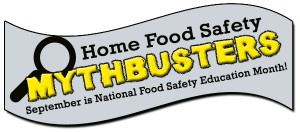Microwaving, nuking, zapping–whatever you call it–using a microwave oven to cook or reheat foods can be fast and convenient, but it is not effective at killing harmful bacteria if the food is not heated to a safe internal temperature, according to the non-profit Partnership for Food Safety Education.
 September is National Food Safety Education Month, and the National Chicken Council is joining with the non-profit Partnership for Food Safety Education to introduce Home Food Safety Mythbusters to consumers.
September is National Food Safety Education Month, and the National Chicken Council is joining with the non-profit Partnership for Food Safety Education to introduce Home Food Safety Mythbusters to consumers.
“Food safety is the No. 1 priority for the chicken industry,” said Tom Super, NCC vice president of communications, in a press release. “By participating with the Partnership on Mythbusters, we help remind people during Food Safety Education Month how to make food safety a priority at home.”
The misconception that the microwaves, rather than the heat that microwave ovens generate, kill bacteria is one of this year’s four featured myths. The myths are presented with the facts consumers need to know to reduce their risk of food poisoning.
- MYTH: “If I microwave food, the microwaves kill the bacteria, so the food is safe.”
Fact: Microwaves are not what kill bacteria–it’s the heat generated by microwaves that kills bacteria in foods. Microwave ovens are great time-savers and will kill bacteria in foods when heated to a safe internal temperature. However, foods can cook unevenly because they may be shaped irregularly or vary in thickness. Even microwave ovens equipped with a turntable can cook unevenly and leave cold spots in food, where harmful bacteria can survive.
Be sure to follow package instructions and rotate and stir foods during the cooking process, if the instructions call for it. Observe any stand times as called for in the directions. Check the temperature of microwaved foods with a food thermometer in several spots.
- MYTH: “Of course I wash all bagged lettuce and greens because it might make me sick if I do not.”
Fact: While it is important to thoroughly wash most fresh fruits and vegetables, if packaged greens are labeled “ready-to-eat,” “washed,” or “triple washed” then the product does NOT need to be washed at home. Pre-washed greens have been through a cleaning process immediately before going into the bag. Re-washing and handling the greens creates opportunities for contamination.
Always handle pre-washed greens with clean hands, and make sure cutting boards, utensils, and countertops are clean.
MYTH: “I do not need to use a food thermometer. I can tell when my food is cooked by looking at it or checking the temperature with my finger.”
Fact: The only sure way to know food is safely cooked is to check the temperature with a food thermometer and confirm it has reached a safe internal temperature. Color, texture and steaming are not indicators that a food is safe to eat. The outside of a food might be steaming hot, but there may be cold spots inside. Temperature must be measured by a food thermometer. This will help ensure not only that a food is safely cooked, but that it is not overcooked. Remember to clean your food thermometer with soap and water after each use.
- MYTH: “I cannot re-freeze foods after I have thawed them–I have to cook them or throw them away.”
Fact: If raw foods such as meat, poultry, egg products, and seafood have been thawed in the refrigerator, then they may be safely re-frozen without cooking for later use. Never thaw raw foods by letting them sit on the kitchen counter. If raw foods are thawed outside of the refrigerator, for example in the microwave or in cool water, they should be cooked immediately. Never re-freeze raw or not fully cooked foods that have been thawed outside of the refrigerator.
“We support the Partnership’s efforts in drawing attention to common misconceptions about safely preparing food during National Food Safety Education Month,” USDA Under Secretary for Food Safety Dr. Elisabeth Hagen said. “Providing accurate food safety information to consumers is a key component to protecting families across the nation from foodborne illness.”
Mythbusters raises awareness of home food safety by drawing traffic to www.fightbac.org, where visitors can download free educational materials on food safety topics. A growing number of food safety educators are taking advantage of these resources–in 2011, there was a 200-percent increase in downloads over the previous year.
“This year’s myths explain how to handle common food safety situations in the kitchen that all consumers encounter, even if they are preparing a simple meal,” said Shelley Feist, the Partnership’s Executive Director. “We want to encourage specific food safe behaviors as a way to help consumers Fight BAC!”
Mythbusters educational materials, including a PowerPoint Presentation, a teachers’ kit, games for children, and more, are all available for free at www.fightbac.org.

